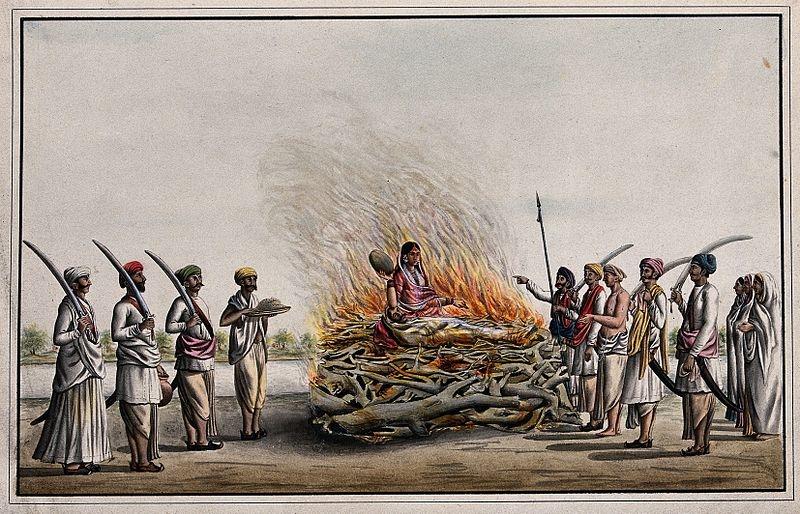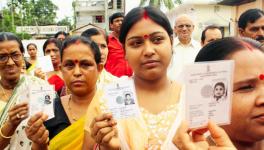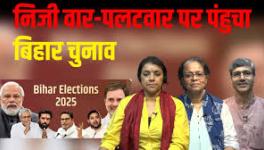Love Patriarchy, Hail Hindu Rashtra!

It was the mid-1980s when a 18-year-old Roop Kanwar’s burning on the pyre of her husband -- under controversial circumstances -- had made national headlines. There was national outrage over the incident because more than 150 years after the banning of this custom -- the practice of Sati, was seeing a revival of sorts. One can still recollect how thousands of women had come out on streets then in different parts of North India, glorifying the act in the name of tradition.
Women were 'celebrating' a woman's self-immolation on the pyre of her husband and resisting state intervention which wanted to enforce her autonomy, her individuality!
This may sound strange today, but was true!
India, had its 'Roop Kanwar moment' -- albeit a bit differently -- once again recently when in Kerala women came out in hundreds or thousands to resist the implementation of Supreme Court judgement that had removed the bar on women aged 10-15 or 'menstruating women's entry in the temple of Ayappa at Sabarimala’.
Assessing the constitutionality of this custom, the apex court had said how a 'dualistic approach against women degrades the status of women' and declared that it is 'unconstitutional and violative of Article 21'. Remember, under Hinduism, a menstruating woman is considered impure and is prohibited from participating in normal life and must be "purified" before she is allowed to return to her family.
Also Watch: Using Allahabad, Sabarimala, and Ayodhya to Polarise India!
As of now, the matter has again gone back to the Supreme Court, as its earlier verdict proved ineffective and there is a flurry of petitions before it challenging its earlier order.
What is noticeable is that in both the cases, divided by a period of more than 30 years, Hindutva supremacists, under the cloak of tradition, had no qualms in supporting customs that were either 'barbaric' and/or 'discriminatory' in nature.
Hindutva supremacists defended Sati
Who can forget how late Vijayaraje Scindia, a very senior leader of the BJP then, had publicly defended the tradition of Sati as a part of 'our' cultural heritage and argued that it was the fundamental right of all Hindu women to commit Sati should they choose to do so. (See, Page 104, Women and The Hindu Right, Ed. Tanika Sarkar and Urvashi Butalia, 1996, Kali for Women.)
Or how a leader of the Hindutva supremacists had then castigated the women protesting the Sati as ‘bazaari auratein’ who were unmarried and would remain so: “How could these women know about ‘pativrata’ or the desire to commit ‘sati’? “The activists were also described as “women with no respect for Hindu religion, with Western ideologies and loose morals who frequented clubs, drank,”
This time as well, there are reports that Rashtriya Swayamsevak Sangh (RSS) and its affiliated organisations played a key role in mobilising protests challenging the implementation of the SC verdict.
We know how women journalists were heckled, their vehicles smashed; young female devotees turned back '[a]s hordes of Hindu right activists besieged the road leading to the hill- top temple, abode to Lord Ayyappa.'
A Malayalam actor supposed to be a BJP supporter, even issued 'an open threat against the ban on entry of women into Sabarimala temple, saying that any woman who attempts to enter the temple should be “ripped apart”.
Smriti Irani, a cabinet minister, rather reinforced the prevalent notion regarding menstruating women, and in an indirect way opposed the SC verdict. Her innocuous looking statement during a discussion which said 'Would you take a blood-soaked sanitary napkin to friend’s home?' was highly criticised on social media.
Also Watch: Present, Past & the Future: Episode 1 - 'RSS: Software Upgrade?'
Mohan Bhagwat, RSS supremo, supposedly provided ideological legitimacy to these protests when he plainly stated how ..[t]he Supreme Court verdict has not taken into consideration the nature and premise of the tradition that has been accepted by society and has given rise to "divisiveness" in society. And he did not forget to give a communal slant to this verdict by adding "why only the Hindu society experiences such repeated and brazen onslaughts on its symbols of faith, obviously arise in the public's mind and lead to unrest" (-do-).
Who could remind Mr Bhagwat about the 2016 court order regarding the Haji Ali Dargah which allowed women inside the sanctum of the tomb?
Or how quickly he forgot about the judgement of the same court which declared triple talaq unconstitutional? As an aside, one can even remember how every activist of the Hindutva Brigade had suddenly turned a defender of Muslim women's rights then but now when the same courts uphold gender equality over tradition in case of Hindus, they had no qualms in changing the tune.
Anyone who has closely followed the trajectory of RSS and its affiliated organisations and related individuals down the years would not find anything surprising in such statements and stands.
Also Read: Celibacy of Ayyappa is an Excuse to Oppress Women
Only very recently, Pon Radhakrishnan, Minister of State for Finance and Shipping and BJP MP from Kanyakumari, termed the #MeToo movement -- which has given the BJP itself many blushing moments -- as being started by “some perverted minds”.
The way the ruling dispensation dealt with the rape of a minor girl in Kathua is still etched in people's memory. Not only did its leaders defend the rapists, but its elected members and ministers even participated in rallies defending the gang of sexual predators.
Whatever be their claims, for the Hindutva brigade -- like all other such formations which are pivoted around mixing of giving primacy to particular religion and politics -- women's autonomy, her individuality, her assertion and her opposition to patriarchy and gender oppression are a ‘no go’ area.
From the days of its first Supremo, Dr Hedgewar, the RSS has always looked at women in hierarchial terms, putting them at secondary status, so much so that it is yet to allow women entry into RSS itself, rather vindicating what it's second Supremo Golwalkar wrote in his book ‘Bunch of Thoughts’ that 'women are predominantly mothers who should rear their children. Women were asked to form a separate organisation calling itself 'Rashtra Sevika Samity' which after 80 plus years of existence, is still focussed on 'imparting sanskar (values) to children and, thereby, strengthening society and the nation.''
In the new look RSS, which supposedly Bhagwat wants to carve out the status quo vis-a-vis women, still remains as it is. In fact, how RSS still believes in secondary status of women was evident even in the question-answer session over his three- day lecture series held recently in Delhi when someone raised a question about its keeping women out and the RSS Supremo had no qualms in admitting that the organisation is just following what their founders have decided as the situation warranted then and he does not see any qualitative change in the situation still.
Also Read: Who’s Protecting Terror Cult Sanatan Sanstha?
It is part of history when leaders of the newly independent India were struggling to have a Constitution that was premised on the inviolability of individual rights, with special provisions of positive discrimination for millions of Indians who had been denied human rights by those quoting religious scriptures, RSS under its then Supremo Golwalkar, espoused the same Manusmriti as independent India’s ‘Constitution’.
It was the same period when attempts were made to give limited rights to Hindu women in property and inheritance through the passage of the Hindu Code Bill., which were opposed by Golwalkar and his followers, with the contention that this step was inimical to Hindu traditions and culture.
How the Hindutva right and the conservative sections within the Congress coupled with the saffron-robed swamis and sadhus joined hands to oppose the enactment of Hindu Code Bill is well-known history. In fact, this motley combination of reactionary and status quoist forces did not limit themselves to issuing statements. They also opposed the Bill on the streets and led large-scale mobilisation at pan India level against the Bill. There were occasions when they even tried to storm Dr Ambedkar’s residence in Delhi.
Their main argument against Ambedkar was that the Bill was an attack on ‘Hindu Religion and Culture’. The enormous resistance to this Bill becomes clear from this excerpt from Ramchandra Guha’s book:
The anti-Hindu code bill committee held hundreds of meetings throughout India, where sundry swamis denounced the proposed legislation. The participants in this movement presented themselves as religious warriors (dharmaveer) fighting a religious war (dharmayudh). The Rashtriya Swayamsewak Sangh threw its weight behind the agitation. On the 11th of December, 1949, the RSS organised a public meeting at the Ramlila grounds in Delhi, where speaker after speaker condemned the bill. One called it ‘an atom bomb on Hindu society’ . . . The next day a group of RSS workers marched on the assembly buildings, shouting ‘Down with Hindu code bill’ . . . The protesters burnt effigies of the prime minister and Dr Ambedkar, and then vandalised the car of Sheikh Abdullah.
Shyama Prasad Mookerjee, founder of BJP’s predecessor, the Bharatiya Jan Sangh, declared that the Bill would ‘shatter the magnificent structure of Hindu culture’.
In his intervention in support of Ambedkar and the Hindu Code Bill during the debate in Parliament on this Bill, Acharya Kriplani stated:
Much has been said about Hindu religion being in danger. I am afraid I cannot see the point. Hindu religion is not in danger when Hindus are thieves, rogues, fornicators, black-marketers or takers of bribes! Hindu religion is not endangered by these people but Hindu religion is endangered by people who want to reform a particular law! May be they are over-zealous but it is better to be over-zealous in things idealistic than be corrupt in material things.
Time someone reads out this statement to the Hindutva zealots who want to keep women subjugated under the cloak of tradition.
Get the latest reports & analysis with people's perspective on Protests, movements & deep analytical videos, discussions of the current affairs in your Telegram app. Subscribe to NewsClick's Telegram channel & get Real-Time updates on stories, as they get published on our website.
























